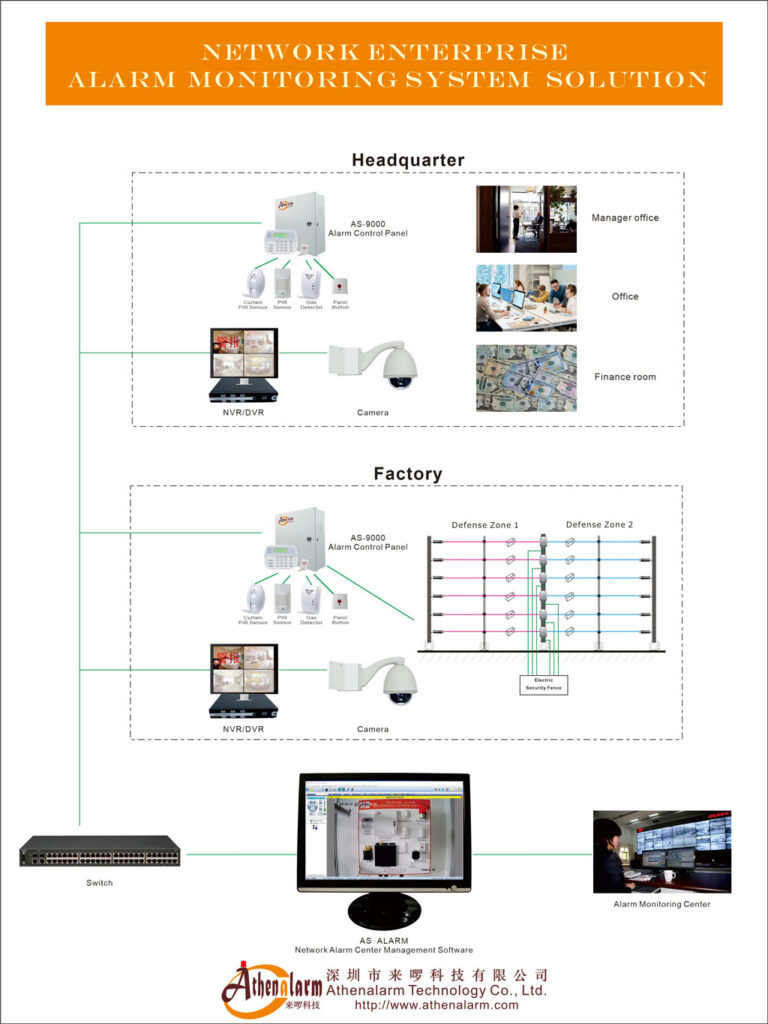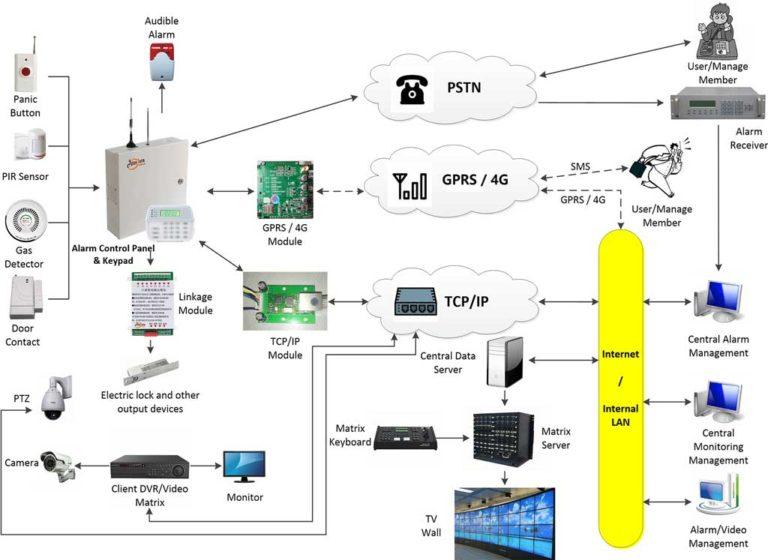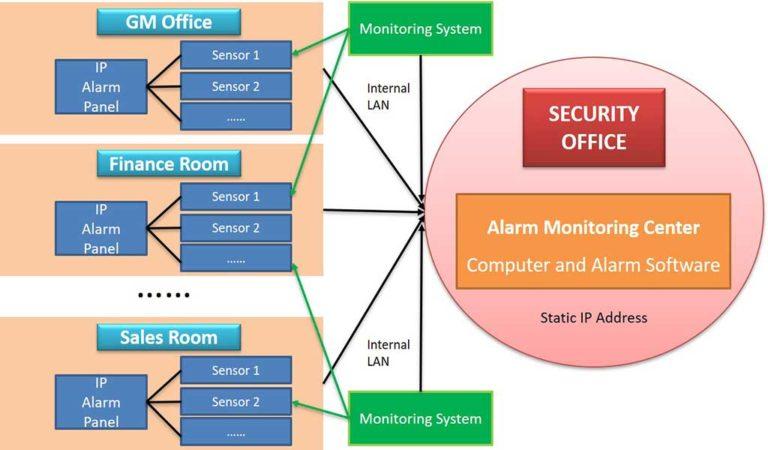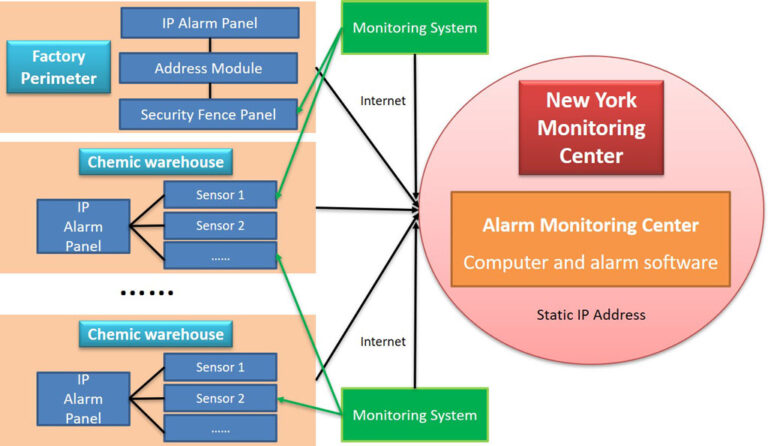



Network Enterprise Alarm Monitoring System Solution

Table of Contents
ToggleThe Growing Need for Modern Enterprise Alarm Systems
As the economy continues to develop, there has been a significant increase in both the number and scale of enterprises. In these organizations, incidents such as fires, explosions, and thefts are frequent, resulting in substantial casualties and property damage. The implementation of a modern networked enterprise alarm monitoring system can effectively reduce the occurrence of these accidents, thereby enabling proactive risk management.
Current Status of Enterprise Security System Development
A recent survey conducted by a research organization across various sectors, including traditional manufacturing, IT manufacturing, and mining, found that the majority of enterprise security systems are relatively basic, with only a few large corporations possessing more sophisticated systems. In general, existing enterprise security systems exhibit the following characteristics:
Limited Application Scope
Most enterprises have established fundamental video surveillance and intrusion alarm systems. However, some still rely on analog cameras, which offer lower image clarity and effectiveness. These cameras are typically installed in high-priority areas such as finance rooms, warehouses, perimeters, plant entrances, workshops, and production lines. The intrusion alarm sensors are mainly located in sensitive zones like financial rooms and warehouses. However, there are few instances where intrusion alarms are integrated with video surveillance. Additionally, perimeter security systems using infrared beams are often prone to false alarms caused by obstructions such as growing trees, weather conditions like rain or snow, significantly reducing their effectiveness.
Varying Levels of System Application
While some enterprises boast relatively complete security system setups with advanced features, others have only basic systems. A few businesses have even invested in security doors and X-ray machines. On the other hand, some enterprises initiated security system construction at a later stage, invested less in these systems, and suffer from inadequate maintenance.
Distinct Demand Patterns
Security requirements vary greatly across industries. For instance, power plant monitoring systems need cameras that are dustproof, explosion-proof, and resistant to strong electromagnetic interference. Steel plant monitoring systems, on the other hand, require cameras capable of withstanding high temperatures and harsh industrial conditions. As such, different industries call for tailored designs and specific equipment choices, as well as integrated security systems that meet the unique demands of each environment. This ensures efficient and scientifically managed operations.
Increased Security Demands with Enterprise Expansion
As the scale of enterprises grows, so does their security demand. In some cases, security system construction has lagged, creating additional safety risks. As businesses expand, there is a growing focus on security management, leading to increased demand for advanced intrusion alarm and video surveillance systems.
The Importance of an Enterprise Alarm System
An enterprise alarm system is not just about protecting physical assets; it’s about safeguarding the continuity and reputation of your business. With growing concerns about security threats—ranging from theft, vandalism, industrial espionage, to workplace violence—having a robust and integrated alarm system is critical. An Enterprise Alarm ensures that your business operates without disruption and your employees and assets are protected. Additionally, it helps reduce insurance premiums by demonstrating your proactive approach to security.
The Purpose of Building an Enterprise Security System
Implementing a robust enterprise security system serves several critical purposes, including:
- Enhanced Personnel Supervision:
The system strengthens the monitoring of personnel entering and exiting the premises, ensuring that all movements are accounted for.
- Timely Detection of Intruders:
By utilizing perimeter defense and intrusion alarm systems, potential intruders can be detected quickly, preventing or minimizing theft incidents.
- Real-Time Production Monitoring:
Video surveillance of workshops and production lines enables managers to monitor production activities in real-time, offering both immediate insights and operational oversight.
- Prevention of Workplace Accidents:
Video surveillance of high-risk areas helps to reduce the likelihood of personal injury incidents by ensuring safety protocols are followed.
Key Features of an Enterprise Alarm Monitoring System
- Remote Monitoring:
One of the key advantages of an enterprise alarm system is the ability to monitor your business in real-time, from anywhere. Whether you are at the office or working remotely, the system provides continuous alerts, video feeds, and status updates, ensuring that security personnel or management can respond quickly to potential threats.
- 24/7 Protection:
An enterprise alarm system operates around the clock, offering constant surveillance and monitoring. This feature is crucial for businesses with irregular operating hours or those located in areas that are prone to criminal activity during the night.
- Scalability:
As your business grows, so will your security needs. A well-designed enterprise alarm system is scalable, meaning you can expand your coverage by adding more sensors, cameras, and integrated systems without disrupting existing security infrastructure.
- Customizable Alerts:
Enterprise alarm systems allow you to set custom alerts based on specific triggers such as motion detection, unauthorized access, or tampering with security equipment. These alerts can be configured to reach the appropriate personnel through SMS, email, or phone notifications, ensuring a timely response.
- Integration with Other Systems:
Enterprise alarm systems can be integrated with other business management systems, such as access control systems, video surveillance systems, and even building management systems (BMS). This integration ensures that all security functions work in sync, providing comprehensive protection.
How an Enterprise Alarm System Works
Enterprise alarm systems typically include several components that work together to provide full coverage:
- Alarm Sensors: These detect unauthorized movements, environmental changes (such as smoke or gas leaks), or physical breaches like door or window openings. Sensors can be placed in various locations depending on the layout and risk assessment of the business premises.
- Video Surveillance: Cameras are installed in key areas of the premises to provide real-time monitoring and video footage for verification of events. With advanced systems, live video feeds can be accessed remotely, providing visual confirmation of alarms triggered by sensors.
- Central Monitoring Station: All the data from the alarm sensors and video surveillance is transmitted to a central monitoring station, either on-site or off-site. This is where alarm events are analyzed and verified before triggering a response. A monitoring center can coordinate emergency responses and dispatch security teams or law enforcement when necessary.
- Alarm Activation and Response: When an alarm is triggered, the system notifies security staff and initiates a response plan, such as locking doors, notifying law enforcement, or activating sirens and lights to deter intruders.
Components of an Enterprise Security System
A comprehensive enterprise security system should align with modern management requirements, effectively safeguarding the perimeter, and providing 24/7 video surveillance of key areas. In addition to these, it must include intrusion alarms, access control systems for key entrances and exits, and electronic patrol systems that integrate both civil and technical defense measures. For enterprises with numerous vehicles, vehicle access and parking are also managed through parking management systems. A typical enterprise security system includes the following core components:
Intrusion Alarm System
The intrusion alarm system serves as the first line of defense, alerting security personnel to unauthorized access. Alarm detectors are strategically placed around the perimeter and in critical areas within the facility to detect any illegal entry. When an intrusion is detected, the system immediately sends an alert to the monitoring center, ensuring a quick response.
The system is designed to detect unauthorized access to the premises, including motion detectors, door/window contact sensors, and glass break detectors. Intruder alarm system is often integrated with other systems such as CCTV, access control, and lighting.
Fire and Smoke Alarm Systems
Critical for protecting life and property, these systems are designed to detect smoke, heat, or fire. They are often integrated into the enterprise alarm system for real-time notification of fire hazards, ensuring a swift evacuation and emergency response.
Environmental Monitoring Systems
These systems monitor for risks such as flooding, gas leaks, or temperature fluctuations that could damage sensitive equipment or inventory. Integrated with the alarm system, they provide an early warning of potential environmental risks.
Video Surveillance System
The video surveillance system is responsible for continuous online monitoring of key areas, such as entrances, exits, warehouses, finance rooms, workshops, and production lines. These areas are under 24-hour surveillance to deter accidents and incidents. Additionally, video footage can be analyzed afterward to determine the causes of events and provide evidence if needed.
Access Control System
Access control system is an essential part of an enterprise alarm setup, controlling who can enter specific areas. Card readers, biometric systems, and keypads restrict unauthorized access to sensitive areas such as server rooms, warehouses, and executive offices.
The system can also integrate with other enterprise systems, such as attendance, consumption, and parking management, enabling a unified security solution using a single access card.
Electronic Patrol System
The electronic patrol system involves setting up patrol points in key areas, including high-traffic routes, computer rooms, warehouses, and finance rooms. Security personnel follow predefined patrol routes within specific time frames, ensuring both civil defense and technical defense. The system offers two modes:
- Offline Mode: This mode does not require wiring to the monitoring center, making it easy to install and scale, although it lacks real-time security updates.
- Online Mode: This mode connects directly to the monitoring center, providing real-time updates on patrol personnel’s identity and location.
Parking Management System
The parking management system ensures organized vehicle access and parking, both for internal company vehicles and external visitor vehicles. It manages functions such as vehicle entry and exit recording, access control, timing, and billing.
Configuration of a Network Enterprise Alarm Monitoring System
For larger enterprises, especially multinational or regionally dispersed companies, managing security across both headquarters and production sites can be complex. This challenge is further compounded by the physical separation of headquarters and production areas, which increases the difficulty of coordinating security efforts. The protection of production areas is especially critical, as many factories are located on the outskirts, where activity may be sparse during both day and night. These areas are vulnerable to criminal activity, with intruders often gaining access via the perimeter fence.
To safeguard the enterprise’s property and ensure its legitimate rights are protected, it is essential to implement specialized security measures and deploy dedicated personnel to maintain effective security. A networked alarm monitoring system is crucial for managing enterprise security operations efficiently.
Establishing a Network Enterprise Alarm Monitoring Center
(1) Creating a Centralized Management Platform
It is vital for enterprises to establish a centralized network alarm monitoring center. This platform will utilize the network enterprise alarm monitoring system to manage security operations across the entire organization, enabling efficient and coordinated oversight of all security activities.
(2) Key Components of the Network Enterprise Alarm Monitoring System
The network enterprise alarm monitoring system consists of three primary components:
- Network Alarm Center Management Software
- Intrusion Alarm System
- Video Surveillance System
These components are seamlessly integrated through the network alarm center management software, which links intrusion alarm systems with video surveillance for a unified approach to security. When an intrusion alarm is triggered, the system automatically connects to nearby cameras, enabling real-time video surveillance of the alarmed area to assist in assessing and responding to the incident.

Establishing an Enterprise Alarm Monitoring Center
(1) Connecting Alarm Monitoring Systems
The enterprise alarm monitoring center connects to the alarm systems across various departments and factories through the company’s internal network or the internet. This integration allows the central monitoring system to access real-time data from different locations within the enterprise, ensuring comprehensive oversight of security operations.
(2) Emergency Response Coordination
In the event of an emergency, the enterprise alarm monitoring center can quickly assess the situation and deploy security personnel accordingly. By evaluating the specific needs of the affected area, the center ensures a prompt and effective response to mitigate the impact of the emergency.
(3) Security Management Oversight
The enterprise alarm monitoring center assumes direct responsibility for overseeing security operations at each affiliated department. Each factory area should establish its own monitoring center to facilitate the management of security tasks within its specific location. These localized centers will work in conjunction with the central enterprise monitoring hub to ensure coordinated and efficient security management.

Setting Up Alarm Monitoring Centers in Each Factory Area
(1) Perimeter Security with Electric Fences and Beam Sensors
Install electric security fences or beam sensors along the factory area’s perimeter, along with a video surveillance system. The network alarm center management software integrates these security measures, linking the defense zones with real-time video monitoring, thus providing comprehensive protection for the enterprise’s perimeter.
(2) Internal Security with Alarm Detectors and Surveillance
Place alarm detectors at strategic points within the factory, such as entrances and exits, corridors, office doorways, and windows. Additionally, install video surveillance systems in these areas. The network alarm center management software connects the detectors to the video feeds, ensuring real-time monitoring and protection of the internal environment.
(3) Panic Buttons and Surveillance for Emergency Situations
Install panic buttons and video surveillance at key locations around the factory, including perimeter walls, main entrances, exits, and critical offices (such as archives, finance departments, and executive offices). In case of an emergency, staff can trigger the panic button, which alerts the enterprise alarm monitoring center. The linked video surveillance system allows the center to assess the situation in real-time, ensuring a swift response.
(4) Sirens for Immediate Alert and Deterrence
Install sirens in key areas like the factory perimeter, outside buildings, corridors, and inside offices. Upon an intrusion alarm, the siren immediately activates, producing a loud sound that deters intruders. The loud alarm also serves as a wake-up call for monitoring staff, ensuring they are promptly alerted, even if they are inattentive during the night.
(5) Alarm Control Panel for Centralized Monitoring
Install an alarm control panel within the factory’s alarm monitoring center, where it will be managed by security personnel. When an alarm is triggered, the control panel displays the specific alarm zone, pinpointing the direction of the intrusion. To ensure immediate action, the factory alarm monitoring center should operate 24/7, with personnel on duty at all times to handle any alarms quickly and effectively.
(6) Real-Time Video Surveillance in Critical Areas
Deploy video surveillance systems in key operational areas such as workshops, production lines, and warehouses. This enables real-time monitoring of production activities and ensures any anomalies or security risks are immediately detected.
For smaller enterprises, a single, centralized alarm monitoring center can effectively manage all these functions, ensuring comprehensive security without the need for multiple sites.

Benefits of an Integrated Enterprise Alarm System
- Enhanced Security:
An integrated enterprise alarm system provides better overall security by linking intrusion alarms, video surveillance, access control, and other systems into one cohesive solution. This allows businesses to monitor and control all aspects of security from a single platform.
- Reduced Risk:
By implementing a robust security system, businesses can mitigate the risks of theft, vandalism, and other security threats. This not only protects physical assets but also reduces the likelihood of disruptions to daily operations.
- Cost Savings:
While the initial investment in an enterprise alarm system may seem high, the long-term cost savings are significant. The system reduces the need for on-site security guards, lowers the risk of insurance claims, and can prevent losses that would otherwise be much higher.
- Peace of Mind:
Knowing that your business is protected 24/7, even when you’re not physically present, provides peace of mind to business owners and managers. This allows them to focus on growing their business while the security system ensures everything is safe.
Choosing the Right Enterprise Alarm System
When selecting an enterprise alarm system, consider the following factors:
- Risk Assessment:
Conduct a thorough risk assessment to determine the security vulnerabilities of your business. Identify high-risk areas and potential threats that the alarm system needs to address.
- Scalability and Flexibility:
Ensure the system can grow with your business. A scalable system allows you to add more sensors, cameras, or features as your business expands without needing to replace the entire system.
- Reliability and Support:
Choose a system from a reputable provider that offers reliable customer support and maintenance services. Having technical support readily available ensures the smooth functioning of your alarm system.
- Integration with Existing Infrastructure:
Ensure the alarm system can be easily integrated with your current security infrastructure, including video surveillance, access control, and building management systems.
Conclusion: Safeguard Your Business with a Comprehensive Enterprise Alarm System
In today’s fast-paced business world, protecting your enterprise from security threats is more important than ever. An enterprise alarm system provides the protection your business needs, offering real-time monitoring, quick emergency response, and peace of mind. Whether you’re a small enterprise or a large corporation, an enterprise alarm system helps mitigate risks, reduce operational downtime, and ensure the long-term success of your business.
Contact us today to discuss how our tailored enterprise alarm solutions can enhance the security of your business. Leave your details, and our experts will help you design a comprehensive security plan that meets your specific needs.
